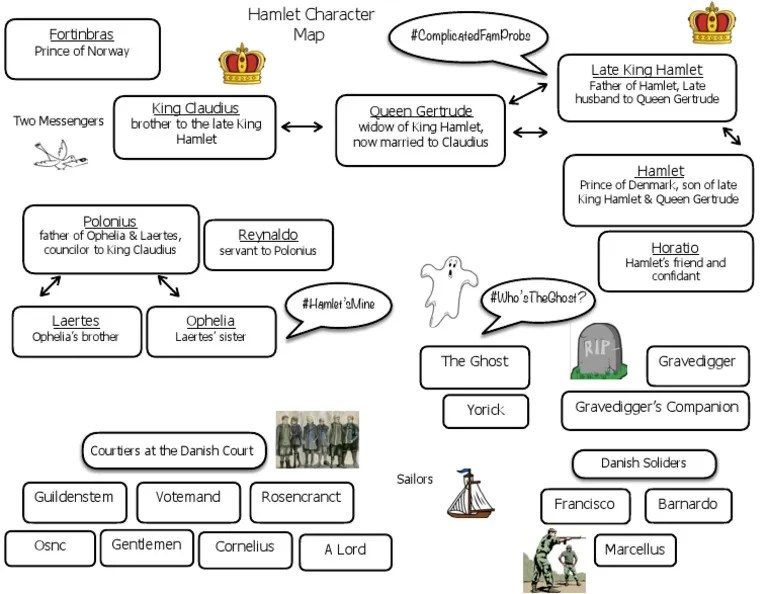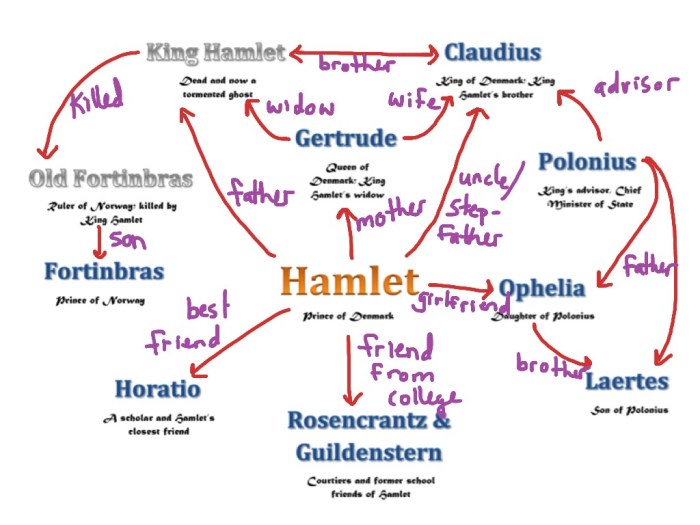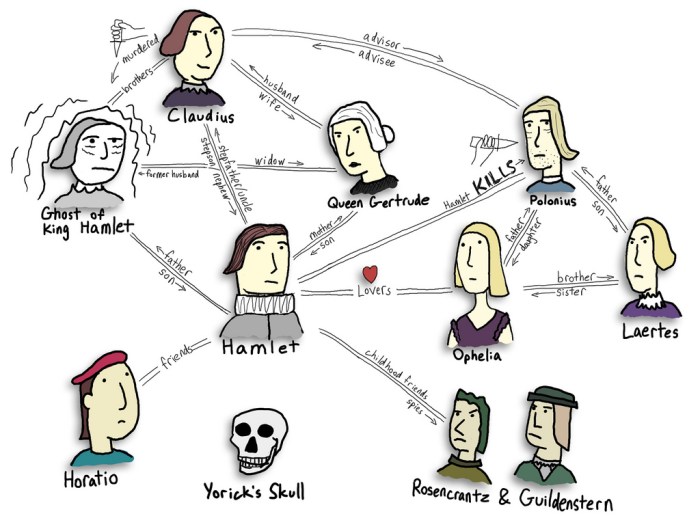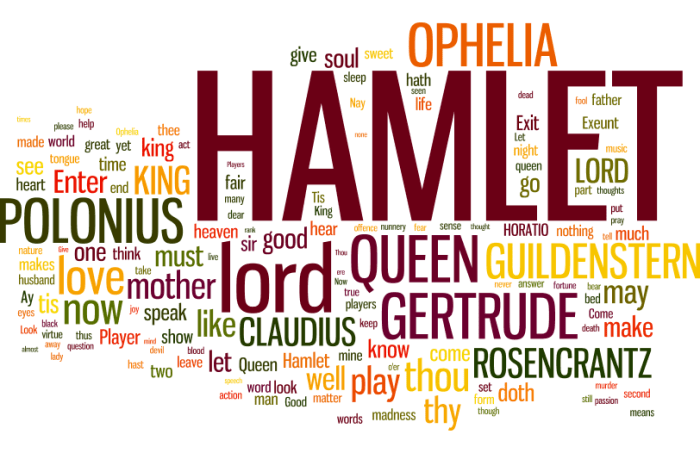Embark on an in-depth exploration of Hamlet Act 3’s intricate web of characters with our comprehensive Hamlet Act 3 Character Map. This interactive guide delves into the motivations, conflicts, and significance of each pivotal figure, unraveling the complexities that drive the play’s compelling narrative.
From Hamlet’s profound transformation to Claudius’s treacherous schemes and Ophelia’s tragic descent into madness, this map provides a comprehensive understanding of the characters’ interplay and their profound impact on the unfolding events.
Character Analysis: Hamlet Act 3 Character Map

In Act 3, Hamlet’s transformation becomes more evident. Driven by grief and anger, he grapples with his newfound knowledge of Claudius’ treachery and his mother’s betrayal. This internal struggle fuels his actions and shapes his interactions with others.
Claudius
Claudius’ guilt and fear intensify as Hamlet’s suspicions grow. He resorts to manipulative tactics, such as planting Rosencrantz and Guildenstern as spies, to monitor Hamlet’s actions. Claudius’ actions reveal his desperation to maintain his power and conceal his crimes.
Ophelia
Ophelia’s mental state deteriorates significantly in Act 3. The loss of her father and Hamlet’s rejection send her into a state of madness. Her fragmented speech and bizarre behavior serve as a poignant reminder of the tragic consequences of the play’s events.
The character map for Act 3 of Hamlet provides a deeper understanding of the complex relationships and motivations driving the play’s plot. To enhance your comprehension of this act, I recommend checking out the unit 7 apush study guide . It offers valuable insights into the historical context and key events shaping American history.
Returning to the character map, it’s crucial to analyze the interactions between Hamlet, Ophelia, Claudius, and Gertrude to fully grasp the evolving dynamics and conflicts within the play.
Polonius
Polonius’ meddling and intrusive nature contribute to the unfolding tragedy. His eavesdropping and scheming ultimately lead to his own demise. Polonius’ death serves as a catalyst for Hamlet’s further descent into despair and madness.
Thematic Exploration

Act 3 of Hamlet delves into profound themes that illuminate the play’s central conflicts and characters.
Mortality and Existence
The “To be or not to be” soliloquy (Act 3, Scene 1) is a seminal exploration of mortality and the existential dilemmas that plague Hamlet. He contemplates the weight of life’s suffering and the allure of death as a release from its torment.
This soliloquy captures the universal human struggle with the fear of death and the uncertainty of what lies beyond.
Madness as a Literary Device
Madness becomes a significant literary device in Act 3. Hamlet’s feigned madness allows him to observe and manipulate those around him while protecting himself from suspicion. Ophelia’s genuine descent into madness highlights the devastating consequences of grief and trauma.
Symbolism and Imagery
The play’s language is rich in symbolism and imagery. The use of water and drowning imagery reflects the characters’ struggles and the overwhelming sense of despair. The imagery of disease and corruption symbolizes the moral decay and treachery within the Danish court.
Structural Analysis

Act 3 of Hamlet is a pivotal point in the play, where key events unfold and relationships between characters become increasingly complex. This structural analysis will explore the act’s significance through an organized table of events, a flowchart of character relationships, a summary of the plot’s progression, and an examination of its contribution to the play’s overall structure.
Key Events and Significance
The following table summarizes the key events in Act 3 and their significance:
| Event | Significance |
|---|---|
| Hamlet’s “To be or not to be” soliloquy | Hamlet contemplates suicide and the nature of existence, revealing his inner turmoil and philosophical musings. |
| Polonius’s eavesdropping and death | Polonius hides behind the arras to spy on Hamlet’s conversation with his mother, leading to his accidental death by Hamlet. |
| Claudius’s confrontation with Hamlet | Claudius suspects Hamlet’s involvement in Polonius’s death and confronts him, revealing his own guilt and desperation. |
| Hamlet’s play-within-a-play | Hamlet stages a play to expose Claudius’s guilt, using it as a trap to confirm his suspicions. |
| Ophelia’s madness and death | Ophelia, driven to madness by Hamlet’s rejection and her father’s death, drowns herself, adding to the play’s tragic toll. |
Character Relationships
The following flowchart illustrates the complex relationships between the characters in Act 3:
- Hamlet: Central character, tormented by grief, suspicion, and indecision.
- Claudius: Hamlet’s uncle and stepfather, who murdered Hamlet’s father and married his mother.
- Gertrude: Hamlet’s mother, who married Claudius after her husband’s death.
- Polonius: Lord Chamberlain, Ophelia’s and Laertes’s father, who meddles in Hamlet’s affairs.
- Ophelia: Polonius’s daughter, who is in love with Hamlet but is driven to madness by his rejection.
- Laertes: Polonius’s son, who seeks revenge for his father’s death.
- Rosencrantz and Guildenstern: Hamlet’s former friends, who are now spying on him for Claudius.
Plot Progression, Hamlet act 3 character map
Act 3 marks a turning point in the play’s plot, as Hamlet’s suspicions about Claudius’s guilt are confirmed and his plans for revenge begin to take shape. The act progresses through the following key stages:
- Hamlet’s soliloquy and his growing sense of despair.
- Polonius’s eavesdropping and his accidental death.
- Claudius’s confrontation with Hamlet and his growing fear.
- Hamlet’s play-within-a-play and the revelation of Claudius’s guilt.
- Ophelia’s madness and her tragic death.
Contribution to Overall Structure
Act 3 serves as a pivotal transition in the play’s structure, bridging the gap between the initial exposition and the climax. It intensifies the conflict between Hamlet and Claudius, heightens the sense of suspense and tragedy, and foreshadows the inevitable downfall of the characters.
Historical and Cultural Context

The portrayal of madness in Hamlet is heavily influenced by the historical and cultural context of the Elizabethan era. During this time, mental illness was often seen as a supernatural or divine punishment, and individuals with mental disorders were frequently subjected to ridicule, abuse, and confinement.
The Elizabethan Worldview
The Elizabethan worldview was shaped by a belief in the divine order of the universe, where each person had a predetermined place and role in society. Madness was seen as a disruption of this order, a sign that the individual had somehow transgressed against the natural laws of the universe.
Gender and Social Norms
The play’s portrayal of madness is also influenced by the gender and social norms of the Elizabethan era. Women were expected to be subservient and chaste, and any deviation from these norms was often seen as a sign of madness.
In Act 3, Ophelia’s descent into madness is triggered by her father’s disapproval of her relationship with Hamlet and her subsequent rejection by Hamlet.
Relevance to Contemporary Audiences
While the historical and cultural context of Hamlet is different from our own, the play’s exploration of madness remains relevant to contemporary audiences. The play challenges us to question our own assumptions about mental illness and to recognize the social and cultural factors that can contribute to its development.
Questions and Answers
Who is the most significant character in Hamlet Act 3?
Hamlet himself undergoes a pivotal transformation in Act 3, grappling with existential questions and seeking revenge for his father’s murder.
What is the significance of Ophelia’s madness in Act 3?
Ophelia’s descent into madness reflects the play’s themes of grief, betrayal, and the fragility of human sanity.
How does Polonius’s role contribute to the events of Act 3?
Polonius’s meddling and eavesdropping inadvertently fuel the conflicts and misunderstandings that escalate in Act 3.

